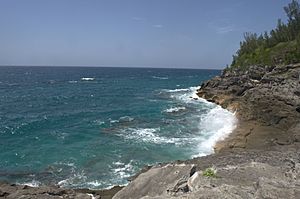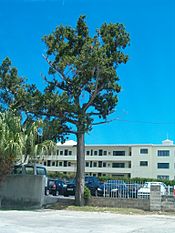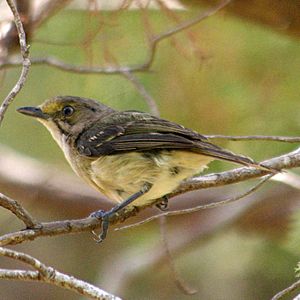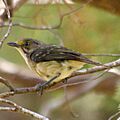Spittal Pond Nature Reserve facts for kids
Quick facts for kids Spittal Pond Nature Reserve, Bermuda |
|
|---|---|
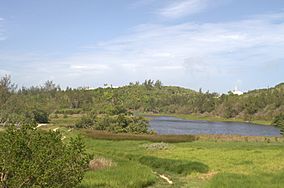
Spittal Pond in Spittal Pond Nature Reserve
|
|
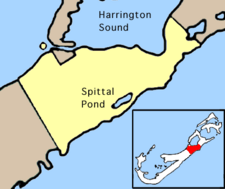 |
|
| Location | Spittal Pond |
| Nearest city | Hamilton |
| Area | 60 acres (24 ha) |
| Established | 1999 |
| Visitors | NA (in NA) |
| Governing body | Bermuda Government and the Bermuda National Trust |
| Designated: | 11 May 1999 |
| Reference #: | (6UK005) |
| UK Overseas Territories Conservation Forum: | UK41006 |
Spittal Pond Nature Reserve is the biggest wildlife sanctuary in Bermuda. It's found near the Atlantic coast in Smith's Parish. This special place covers about 60 acres and surrounds Spittal Pond, which is the third largest pond in Bermuda.
The reserve is one of 13 parks looked after by the Bermuda Department of Conservation Services. They work to protect important natural areas and animal homes. Spittal Pond is also a "Ramsar Site," which means it's a wetland of international importance. It was given this special title in 1999 because of its unique features. These include its permanently brackish (slightly salty) lagoon, its wet grasslands, and its mangrove forests. It's also a vital spot for many types of birds, especially waterbirds and European eels.
Contents
Exploring Spittal Pond Nature Reserve
Spittal Pond Nature Reserve is located in Smith's Parish. It has a rocky shoreline with cool limestone pavement formations, sometimes called "the Checkerboard." Even though it looks like a freshwater pond, the water is actually a bit salty. This is because the nearby Atlantic Ocean can flood the pond during big storms.
How Storms Affect the Pond
Strong storms like hurricanes are common in Bermuda. During these storms, huge ocean waves can crash over the thin line of small hills that separate the pond from the ocean. This causes the pond to fill with ocean water, silt, and even trees. For example, in 2003, a hurricane caused a 12-meter wave that flooded the pond.
When the pond gets flooded with salty water, parts of it can change color and smell bad. This happens because special bacteria that like salty conditions start to grow. The reserve is mostly made up of mudflats and salt marshes. It also has areas of freshwater, tidal flats, and rocky shores. The hills around the pond are covered in thick forests.
Climate and Water Levels
The weather here is subtropical, meaning it's mild and humid. This climate is perfect for both birds that live here all the time and those that just visit. Besides the main Spittal Pond, there are two smaller ponds nearby. These were dug in 1966 to collect freshwater.
The water level in the pond can change a lot, sometimes by about 75 centimeters. This depends on how much it rains and if there's flooding from the sea during hurricanes. When the water level is low, muddy areas appear in the lake. The main type of rock here is limestone, and you can even find fossils of old palm trees in it.
Plants and Scenery
During the summer, many tropical trees, plants, and flowers grow in the reserve. In winter, the park offers beautiful views for visitors walking along its many trails.
A Look Back: History of Spittal Pond
The name "Spittal Pond" might come from places in Scotland. In the past, it was also called Brackish Pond because of its salty water, or Peniston's Pond after the family who owned the land. The name "Spittal" might have been used because the area was once a hospital and a place for cattle to graze.
In the early 1900s, this reserve was made up of 10 different pieces of private land. It wasn't developed much because it was a salty marsh. In 1946, Dr. Henry Wilkinson, a doctor and historian, turned his part of the land into a reserve. Over time, the Bermuda government bought more land, and together with the Bermuda National Trust, they created the Spittal Pond Reserve. Today, it's the largest nature reserve and wildlife sanctuary in Bermuda.
Ancient Markings: The Spanish Rock
There's a cool historical spot called "Spanish Rock" (or "Portuguese Rock") on a rocky cliff overlooking the ocean. It has old carvings from 1543 AD and other unclear writings. People think the carvings include "RP" (which might mean "Rex Portugaline," or King of Portugal) and a cross, showing a connection to the Portuguese Order of Christ. The original rock piece has been moved and replaced with a bronze plaque. A copy of the rock is on display at the Bermuda Historical Society Museum in Hamilton.
Because of its many different habitats and rich wildlife, especially birds that visit in winter, Spittal Pond was named a Wetland of International Importance (a Ramsar Site) in 1999.
Impact of Hurricanes
Hurricanes have caused damage to the reserve over the years. In 1987, Hurricane Emily hurt many casuarina trees. Then, on September 5, 2003, Hurricane Fabian caused a lot of damage. It was the strongest hurricane to hit Bermuda since 1963. Hurricane Igor in September 2010 also caused more damage to the reserve.
Amazing Wildlife at Spittal Pond
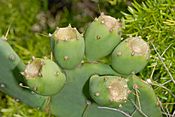
Many native plants and trees, like the Bermuda cedar (Juniperus bermudiana), have been harmed by plants brought in from other places. These include the Mexican pepper (Schinus terebinthifolius), Australian whistling-pine (Casuarina equisetifolia), and Chinese fan palm (Livistona chinensis).
The reserve also has mangrove swamps and salt marshes, which form when the sea floods the pond during storms. There are also large wooded areas. You can find plants like palmetto (Sabal bermudana), bay grapes (Coccoloba uvifera), and allspice (Pimenta dioica). Common shrubs include lantana, Spanish bayonet (Yucca aloifolia), and fluorescent green flopper (Kalanchoe pinnata). There are plans to replace the non-native trees with plants that naturally belong in Bermuda.
Animals of Spittal Pond
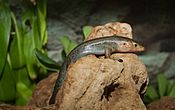
Other animals living in Spittal Pond Nature Reserve include the Bermuda rock skink (Plestiodon longirostris), which is a critically endangered species. You might also spot silver-haired bats (Lasionycteris noctivagans), Sally Lightfoot crabs, and buckeye butterflies (Junonia coenia). In the spring, you can sometimes see migrating humpback whales from Portuguese Rock. Eels (Anguilla anguilla) are also common here.
Birds of Spittal Pond
Spittal Pond is a very important stop for birds flying across the Atlantic Ocean. This makes it a great place for birdwatching. About 20 different bird species spend the winter here, and over 200 species are seen as they migrate through. You can often see 25 types of waterfowl, like geese and flamingoes.
Some common birds you might spot include the Bermuda white-eyed vireo, cattle egret, great egret, snowy egret, American black duck, ring-necked duck, American wigeon, Eurasian teal, and blue-winged teal. There are also waders, coots, moorhens, and different kinds of herons like the great blue, green, and tricoloured herons. In the spring, longtails, or white-tailed tropicbirds, are a common sight. Shorebirds include various shanks, dowitchers, and sandpipers. Small fish called Eastern mosquitofish are found in large numbers. They help control mosquitoes and provide food for the herons. White-tailed tropicbirds are known to build their nests on the coastal cliffs.
Images for kids


